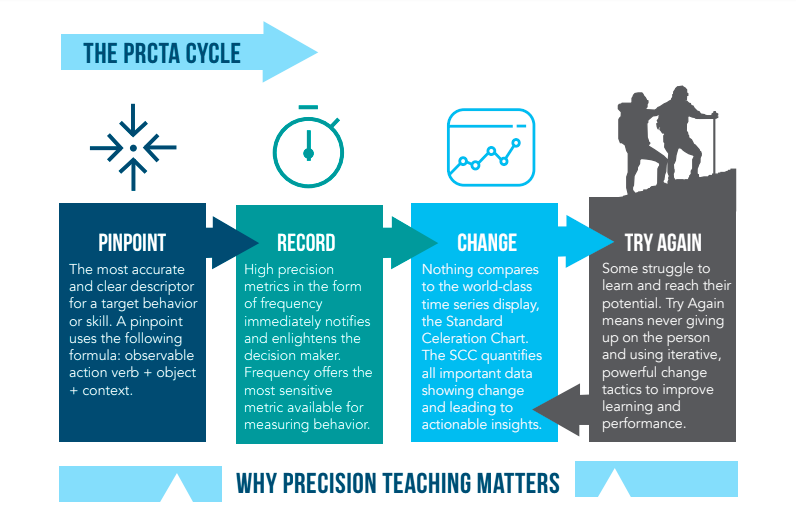By Dr. Rick Kubina, BCBA-D | CentralReach Director of Research
Many clinical professionals have adopted a data-driven approach. “Data-driven” means what it implies, using data to inform instructional practices (not having Data from Star Trek drive you around like Miss Daisy). Successful practices incorporate data-driven methods throughout their culture.
Data-driven also holds practitioners engage in a cycle of assessment, analysis, and action. Does that cycle sound familiar?
Precision Teaching forms a streamlined system of assessment, analysis, and action with its PRCTA (Pinpoint-Record-Change-Try Again) cycle. A host of peer-reviewed articles and books have documented the success of the PRCTA cycle. While the whole system would take more than a single blog post, focusing in on core change measures does not.

The Secret Sauce
What distinguishes Precision Teaching and Chartlytics from all other progress monitoring/data discovery programs lies is this: the Standard Celeration Chart (SCC) and its accompanying change measures (metrics). The infographic below shows three basic measures born from the SCC. Each measure does something you won’t find anywhere else (not on non-standard graphs, which aren’t designed to show behavior change).

Simply put, better , more informative metrics and a standard view of graphical features allow chart readers to fully see the data story. Let’s look today at learning speed, a.k.a. rate of change.
Learning Speed
How fast does performance data change? A client learning how to tie her shoes could take one day, one week, one month, or one year. The speed of learning measured by celeration directly reflects upon the intervention used to teach shoe tying. Any change in a pinpoint comes from the power of an intervention (or instruction or treatment). How useful/good would you rate an intervention that takes one week versus one month? Which interventions do students/clients/ourselves deserve?
Measuring a performance for one day tells us how the person completed the task. If we take frequency data, we know how long it took the person to complete the task.
But when we string those individual performances together across time we call the change learning. Learning appears graphically on an SCC with a celeration line. Each celeration line visually depicts the speed with its slope with a celeration value. A x1.4 value means the behavior grew or multiplied 1.4 times. A x1.4 value also means a 40% weekly change. A x2.0 represents a weekly doubling and a 100% growth rate.
On the other side of the celeration fan (Figure 1) behavior can decelerate and the value states how fast decay occurs. As an example, a ÷1.4 means a behavior divided 1.4 times, a 29% change (e.g., starting a week at 14 under a ÷1.4 will yield 10 at the end of the week). Likewise a ÷2.0 shows behavior halving each week, a 50% lessening.
Viewing the rate of growth or decay allow us to optimize learning. We can tell if a client is progressing too slowly (or faster than anticipated). Seeing a celeration line with a value of x1.1 would lead the chart reader to implement a change due to the slow 10% growth rate.
Let’s look at an example of a pinpoint (behavior) growing at the speed of a x1.1. The chart below shows the celeration of a client who started at 6 letter sounds correct per minute. Looking at the minimum aim for letter sounds, 100 letter sounds per minute, we see the typical daily SCC can’t handle all the days necessary to show the change. All Standard Celeration Charts have 20 periods (140 days on the daily chart). I added 49 more days just to show how long it takes to get to the aim of 100, an astounding 27 weeks!

Speed matters. We don’t want any student having to suffer through almost 190 days of instruction to reach their goal. But without the SCC, clinicians can’t easily see how quickly a client is progressing. With the celeration line (projecting forward to communicate the time to aim), how can you really know how long your intervention will take?
Conclusion
Our fields have a number of happy declarations and platitudes that sound inspiring: “Aim for excellence,” “We won’t leave any child behind,” and “Success, nothing less.” No one argues with the sentiment of such statements. We all want to live in a better world and plant the seeds of a bright future for our children and the younger generation through clinical and educational distinction.However, for stellar outcomes, academic prosperity, and masterful skill development, we must pay heed to metrics like celeration. The faster someone learns, the more time he or she has to learn other skills. Use celeration (rate of change) to empower faster outcomes for better lives.

Dr. Rick Kubina, BCBA-D
CentralReach Director of Research
Richard M. Kubina Jr., Ph.D., BCBA-D is a Professor of Special Education at The Pennsylvania State University and teaches courses on methods for teaching reading, behavior analysis, and experimental design. Rick graduated from Youngstown State University where he had Steve Graf as an advisor and then received a Masters and Ph.D. from The Ohio State University under John Cooper.
Rick conducts wide-ranging research in the area of Applied Behavior Analysis and Precision Teaching. He also served as the editor of the Journal of Precision Teaching and Celeration. He has dedicated his professional career to helping behavior change agents such as teachers, behavior analysts, and other helping professionals efficiently change behavior through effective teaching and measurement such as Precision Teaching. Rick co-founded a software called Chartlytics. Chartlytics merged with CentralReach where Rick has assumed the role of Director of Research.
At CentralReach, Rick explores how technology can accelerate superior outcomes for all those seeking to engender professional and personal success.
About CentralReach
CentralReach is the leading provider of Autism and IDD Care Software, providing the only complete, end-to-end software and services platform that helps children and adults diagnosed with autism spectrum disorder (ASD) and related intellectual and developmental disabilities (IDD) - and those who serve them - unlock potential, achieve better outcomes, and live more independent lives. With its roots in Applied Behavior Analysis, the company is revolutionizing how the lifelong journey of autism and IDD care is enabled at home, school, and work with powerful and intuitive solutions purpose-built for each care setting.
Trusted by more than 200,000 professionals globally, CentralReach is committed to ongoing product advancement, market-leading industry expertise, world-class client satisfaction, and support of the autism and IDD community to propel autism and IDD care into a new era of excellence. For more information, please visit CentralReach.com or follow us on LinkedIn and Facebook.
Media Contact:
CentralReach
pr@centralreach.com




